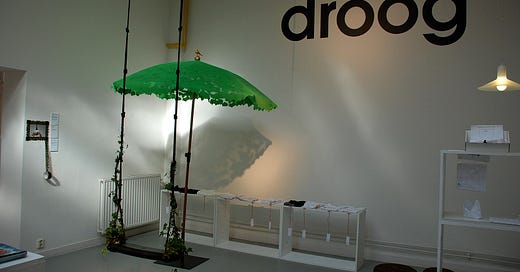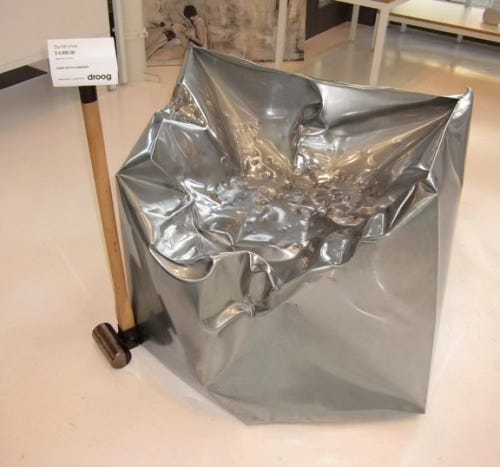Radical ironic funny irregular design
Review of Droog Design in Context: Less + More by Renny Ramakers
This book, by one of the founders of what was for a time one of the hottest design groups in the world, presents an original philosophy. His concepts are as important as the images and appearance of their products – there are real substantive ideas that are well expressed and not just adjuncts to nice photos, which in my opinion is the disease of design books. The book is also a critique of both modernist and post-modernist design movements. Finally, it offers a manifesto for a new consumer-oriented movement that is unlike any other that I am aware of.
Droog is an informal grouping that started out Dutch and has expanded to include some of the best young designers in the world. The movement it represents and propels is a rebellion against the overly ornate and sculpted perfection that past industrial and architectural design saw as an ideal. Instead, Droog designers are out to entirely re-make the design process: rather than aesthetic taste (or functionalist ideals), their approach is more conceptual, poking fun at overly serious or bourgeois design, while critiquing modern society and staying ecologically aware. From "Less is More" (modernism) to "Less is a Bore" (postmodernism), Droog wants to say "Less and More." This might appear difficult to comprehend, but this book lays it out very clearly for anyone who knows the history of design and its various movements.
To accomplish their vision, Droog designers sometimes take old objects and re-cycle them by giving them new meaning, purposefully introducing flaws, uncertainty, and direct consumer participation into the design process and employing both old and new technologies in novel ways. All the while, there is an undertone of irony and chance to what they do, with many objects turning out unique and unreproducible in larger scale production. For example, they produce a dinner service that isn’t uniform: every plate is different, each malformed in its own way.
If I could sum it up, Droog has created a kind of conceptual art for consumers, much like Duchamp and the Dadaists did for modern art, taking the observers' interest away from the appearance of the object in favor of an idea behind it.
I once interviewed Ramakers, who is one of those remarkably energetic innovators and leaders. He gave me 20 minutes and I got more idea than I usually would get in 3 hours with most interviewees. If I’m lucky, I meet one or two people like that per year. What he does is catalyze events at which designers can congregate and exchange ideas, much like a happening of the 1960s but resulting products that can sell as much as be exhibited. The object below (the do-hit chair) is typical: it starts as a metal cube, which the consumer is supposed to smash into the shape of a chair. Figure-toi.
Time will tell how well they succeed. Apparently, Droog does turn a modest profit. The kind of things they produce are chairs woven entirely out of high tech fiber and dipped in epoxy to keep their form, a "dresser" of old drawers that the purchaser must band together by a movers' strap rope (adding anything else they may desire to it), and a bundle of ordinary lightbulbs forming a chandelier that resembles a bouquet of flowers. This results not in traditional notions of beauty, but highly provocative and thoughtful products. For myself, I am uncertain if I like – or would want to own – what they turn out, but their vision and methods are fascinating and have represented a great influence in the design world. So for design lovers and professionals, this book is a must have.
See: https://www.droog.com





